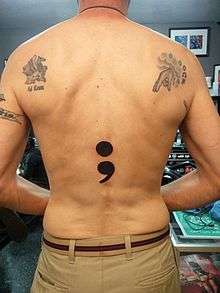Project Semicolon
 | |
| Founded | 2013 |
|---|---|
| Founder | Amy Bleuel |
| Type | 501(c)(3) |
| Focus | Achieving lower suicide rates in the U.S. and around the world |
| Location | |
| Origins | Founded ten years later after the death of Amy Bleuel's father by suicide in 2013. |
Area served | Worldwide |
| Method | Mental health advocacy |
| Slogan | Your story is not over. |
| Mission | Dedicated to presenting hope and love for those who are struggling with mental illness, suicide, addiction and self-injury. |
| Website | projectsemicolon.org |
Project Semicolon (stylized as Project ;) is an American mental health 501(c)(3) nonprofit organization founded in 2013. The movement calls for, "presenting hope and love to those who are struggling with depression, suicide, addiction, and self-injury." They are primarily known for encouraging people to draw (or tattoo) the punctuation mark semicolon (;) on their bodies as a form of solidarity between people dealing with mental illness or death of someone from suicide.[1]
Although a Christian faith-based organization, the movement is inclusive for people holding different beliefs or religions.[2][3][4]
History
Project Semicolon was founded by Amy Bleuel in 2013, as a tribute to her father, who committed suicide in 2003.[5] She is Christian.[3][4]
Amy Bleuel
Bleuel lives in Wisconsin. After her parents divorced, Bleuel chose to live with his father and his second wife at the age of 6. Since then, Bleuel endured being physically abused by her stepmother. At the age of 8, she was taken into state custody by a child protective service. Bleuel said that she started self-harming and attempting to kill herself after she had been sexually abused at the age of 10,[3] and raped at 13. At the age of 18, Bleuel's father died from suicide, and she was subsequently released from the system.[6] In her early years in college, Bleuel was raped twice, and suffered a miscarriage.[6] Bleuel suffered from alcoholism at the age of 30 and had four major suicidal attempts.[3]
Overview
Project Semicolon defines itself as "dedicated to presenting hope and love for those who are struggling with mental illness, suicide, addiction and self-injury", and "exists to encourage, love and inspire."[7] While they are devoted to achieving lower suicide rates in the U.S. and worldwide, they do not themselves practice psychiatry, and the staff are not trained mental health professionals.[4] Rather, they recommend contacting emergency hotlines (e.g. 9-1-1 or the National Suicide Prevention Lifeline) or seeking mental health professionals.[8]
Advocacy

The organization explains that "a semicolon is used when an author could’ve chosen to end their sentence, but chose not to. The author is you and the sentence is your life."
The movement became prominent early in July 2015. People have started uploading photos of their own semicolon tattoos through social media to support the movement, gaining attention from a variety of mainstream news outlets.[1][2][4][9][10][11][12]
Amy Bleuel has remarked on the initial outcome of the 2016 U.S. Presidential Election, crisis hotlines having reported a major uptick, that "There’s valid fear and fear drives suicide. Also sadness drives suicide. So these people are feeling this and it’s at an overwhelming extent that they’re choosing to go that route."[13]
See also
References
- 1 2 Grisham, Lori (July 9, 2015). "Semicolon tattoos raise awareness about mental illness". USA Today. Retrieved October 18, 2016.
- 1 2 Steyer, Carly (July 7, 2015). "Global Semicolon Tattoo Trend Is A Sign Of Strength Among Faithful Individuals Dealing With Mental Health Problems". Huffington Post. Retrieved October 18, 2016.
- 1 2 3 4 Rollins, Mark (June 27, 2016). "Interview with Amy Bleuel, Founder of Project Semicolon, and How to Fight Depression, Addiction, Suicide, and Self-Injury". The Gospel Herald. Retrieved October 18, 2016.
- 1 2 3 4 Reinis, Samantha (July 9, 2015). "The Moving Meaning Behind the Viral Semicolon Tattoo". The Daily Signal. Retrieved October 19, 2016.
- ↑ "Project Semicolon — Our Founder". projectsemicolon.org. Retrieved October 18, 2016.
- 1 2 "Why Me God? Why My Testimony? - A Story of Hope in The Midst of Despair". projectsemicolon.org. Retrieved October 18, 2016.
- ↑ "Project Semicolon — Our Vision". projectsemicolon.org. Retrieved October 18, 2016.
- ↑ "Project Semicolon — Our History". projectsemicolon.org. Retrieved October 19, 2016.
- ↑ Tweedy, Jo (July 2, 2015). "The tattoo designed to end mental health taboo: Thousands support social media trend to have a semicolon inking". DailyMail. Retrieved October 19, 2016.
- ↑ Dupere, Katie (July 7, 2015). "Semicolon tattoos are a new way to talk about mental health". Mashable. Retrieved October 19, 2016.
- ↑ Willard, Laura (July 8, 2015). "Have you seen anyone with a semicolon tattoo? Here's what it's about.". Upworthy. Retrieved October 19, 2016.
- ↑ Bolton, Doug (July 4, 2015). "People all over the world are getting semicolon tattoos to draw attention to mental health". The Independent. Retrieved October 19, 2016.
- ↑ Matesic, Emily (11 November 2016). "Presidential politics leading some to seek mental health help". wbay.com. Retrieved 16 November 2016.